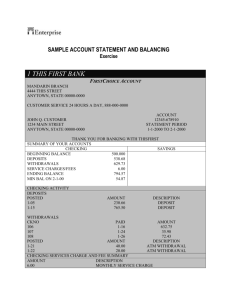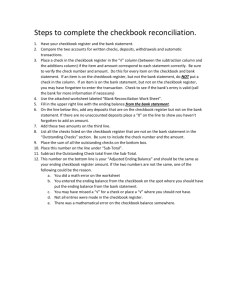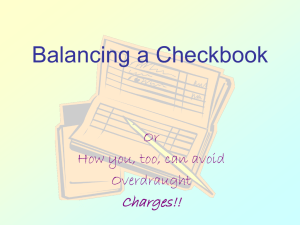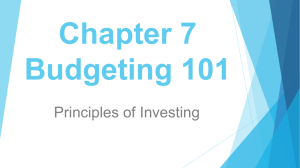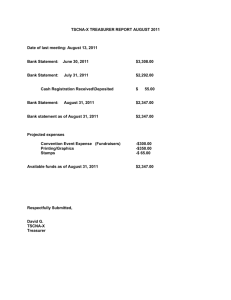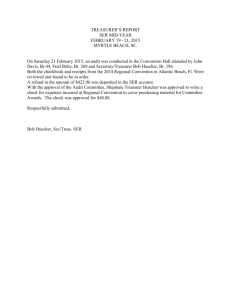Financial Management Guide
advertisement
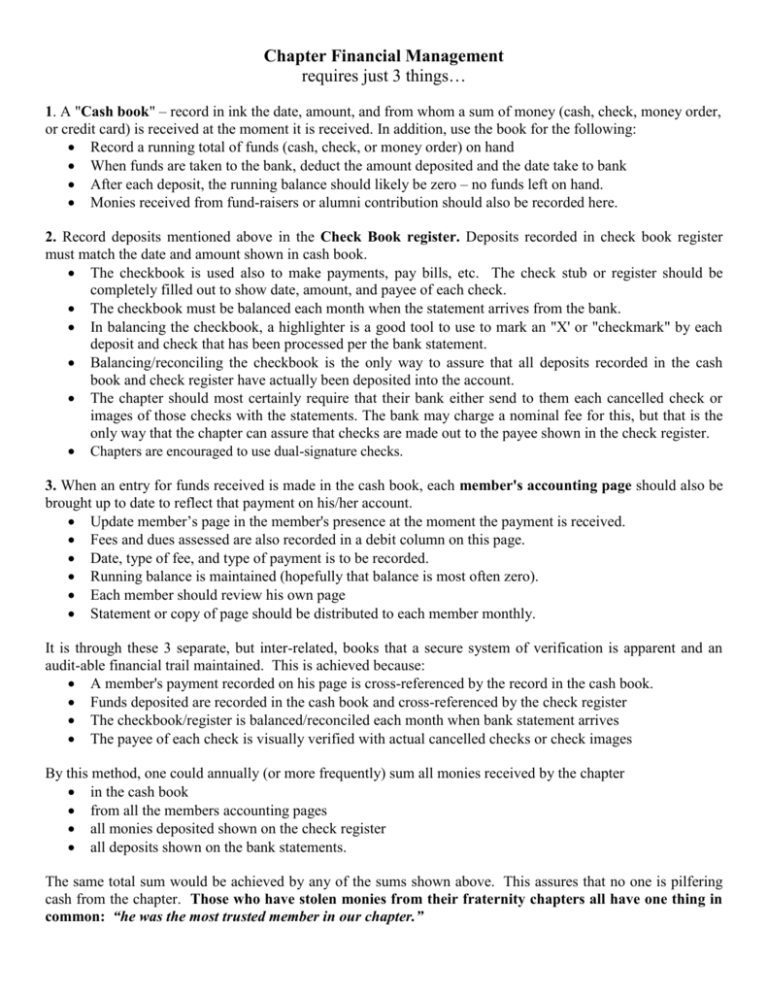
Chapter Financial Management requires just 3 things… 1. A "Cash book" – record in ink the date, amount, and from whom a sum of money (cash, check, money order, or credit card) is received at the moment it is received. In addition, use the book for the following: Record a running total of funds (cash, check, or money order) on hand When funds are taken to the bank, deduct the amount deposited and the date take to bank After each deposit, the running balance should likely be zero – no funds left on hand. Monies received from fund-raisers or alumni contribution should also be recorded here. 2. Record deposits mentioned above in the Check Book register. Deposits recorded in check book register must match the date and amount shown in cash book. The checkbook is used also to make payments, pay bills, etc. The check stub or register should be completely filled out to show date, amount, and payee of each check. The checkbook must be balanced each month when the statement arrives from the bank. In balancing the checkbook, a highlighter is a good tool to use to mark an "X' or "checkmark" by each deposit and check that has been processed per the bank statement. Balancing/reconciling the checkbook is the only way to assure that all deposits recorded in the cash book and check register have actually been deposited into the account. The chapter should most certainly require that their bank either send to them each cancelled check or images of those checks with the statements. The bank may charge a nominal fee for this, but that is the only way that the chapter can assure that checks are made out to the payee shown in the check register. Chapters are encouraged to use dual-signature checks. 3. When an entry for funds received is made in the cash book, each member's accounting page should also be brought up to date to reflect that payment on his/her account. Update member’s page in the member's presence at the moment the payment is received. Fees and dues assessed are also recorded in a debit column on this page. Date, type of fee, and type of payment is to be recorded. Running balance is maintained (hopefully that balance is most often zero). Each member should review his own page Statement or copy of page should be distributed to each member monthly. It is through these 3 separate, but inter-related, books that a secure system of verification is apparent and an audit-able financial trail maintained. This is achieved because: A member's payment recorded on his page is cross-referenced by the record in the cash book. Funds deposited are recorded in the cash book and cross-referenced by the check register The checkbook/register is balanced/reconciled each month when bank statement arrives The payee of each check is visually verified with actual cancelled checks or check images By this method, one could annually (or more frequently) sum all monies received by the chapter in the cash book from all the members accounting pages all monies deposited shown on the check register all deposits shown on the bank statements. The same total sum would be achieved by any of the sums shown above. This assures that no one is pilfering cash from the chapter. Those who have stolen monies from their fraternity chapters all have one thing in common: “he was the most trusted member in our chapter.” Variances Items which would lead to these sums above not matching are the following: Fundraisers or outside revenue not received from members and not appearing on their individual accounting pages Credits given to member in lieu of actual reimbursements for expenses for events/activities (this variance can be overcome if members are reimbursed via chapter check, rather than by issuing credits to their account). Itemized receipts should be required for all transactions. Isn’t this a lot of work? It is quite trivial if the record keeping is done contemporaneously at the time the transaction takes place. Balancing/reconciling the checkbook only happens 12 times per year (monthly) statements. In addition, only by physically viewing cancelled checks or bank statement images of those checks can it be assured that the check register is correct with respect to whom the check is written and the amount of the check. In this respect, viewing the checks is vital. Can some of this be done electronically? Yes, but numbers typed into an excel spreadsheet can be changed. Items penned in on paper cannot so easily be changed (or at least cannot without being visibly apparent). Also, when there is a change in Treasurer to one not comfortable with excel (or some other financial software), there is a loss of knowledge in the attempt to return to a pen and paper method of bookkeeping. Furthermore, paper records can be updated wherever the Treasurer has the records (ie, at any meeting anywhere), not just when he is next to the computer that has the files stored. Explain again why shouldn’t we issue credits to members’ accounts Members should never receive "credits" on their accounts for monies spent on behalf of the chapter. Instead, the chapter should cut a check to the member. Such credits or expenses on behalf of the chapter rightly belong as expenses in the checkbook, they should not show up as "false" (money not actually received) credits on the member's accounting page. This will also assist the chapter in budgeting efforts since it will have from its checkbook a more accurate representation of its past expenses. The use of “petty cash” is discouraged since they provide an easy source of income for one willing to steal. Even small amounts taken over time add up to significant sums. A word about ATM/Debit Cards While sometimes convenient, it is never necessary for your chapter officers to have an ATM card, checkcard, credit card, or authority to transfer funds electronically or by telephone. Inherent with the convenience of these electronic banking practices come greater risk of theft. Put simply, avoid the use of debit and/or credit cards. However, if used, a chapter should implement strict guidelines and oversight for said use. Limit usage authority to the Treasurer. The Treasurer must make available all financial records upon request by any student member to ensure financial transparency. Methodology for Review of Chapter Finances Several separate items must be reviewed to ensure that the financial records kept by the Treasurer are accurate and up-to-date. They are the following: 1. checkbook register (where monies deposited and checks written are recorded) 2. member accounting page (where sums due and paid for each member are recorded) 3. cashbook (where funds collected from all sources and deposited to the bank are recorded) Each of those 3 pieces above interacts with one another to provide the overlap necessary to ensure a proper system of verification. Ultimately, final verification rests with each member verifying the accuracy of his own accounting page on a regular basis, and officers verifying that the bank account has been reconciled/balanced each month. We will begin with the last of these: In the cashbook, the Treasurer should record all monies (cash, checks, or credit card) received by the chapter from any and all sources. These monies should be summed so that a running tally is maintained. When those funds are taken to the bank and deposited, the running tally should be then zero, and the amount shown in the cash book taken to the bank for deposit should match the amount recorded in the checkbook register as a deposit. A new running tally should then be started in the cash book when additional monies are paid to the chapter. Cash should never be taken from these funds or subtracted from the cashbook to reimburse members; reimbursement should be done by check only written to the member. The member accounting page should be distributed to each member periodically (at least monthly) to assure that it is up-to-date and that the amount shown as balance due (hopefully zero) is accurate. The amount shown as having been paid on each accounting page, should match in date, amount, and member to an entry line in the cashbook. This aspect of reviewing chapter finances falls to each member to ensure that his account is being properly maintained. The checkbook register must be balanced/reconciled each month. Balancing the checkbook is the only way to ensure that the amounts deposited and paid out reported by the Treasurer are accurate, and that some false balances and deposits are not being maintained in a ‘second set of books.” Each check recorded in the register should be matched to an actual cancelled check, an image of that cancelled check, or the check number and amount shown on the bank account statement (the last of these three being the least helpful since the bank statement will never show who the payee is, and as a result one could write a check to himself while showing it in the register as having been paid to some other entity). Deposits recorded in the checkbook register, in the cash book, and on the bank statement should all match. If all these three things are reviewed, you will have conducted a satisfactory review of your chapter finances. This assumes that you have just one chapter bank account. If you have a savings account in addition to a checking, you should also reconcile it with its monthly statements and review transfers in and out of the account. In addition, however, you can also do the following more macro-level/over-arching review: Add up all sums paid recorded on each member’s accounting page, add that number to the balance (per the bank statement, not your checkbook) in your chapter bank accounts on January 1, 2001 (as an example), subtract from that number all checks written out of the account since January 1, 2001. That value should then equal the balance in your bank accounts on today’s date (per the bank statement, and assuming that all checks written out have cleared the bank and all deposits to the bank have been credited). Should you have any questions as you work through this process please do not hesitate to be in touch with our Central Office by whatever means most convenient. Thank you.
